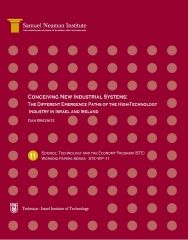In the last decade, both Israel and Ireland have been on the forefront of a successful double revolution. In the international arena, the two small states have been the hotbeds of new technology based firms (NTBF) that establish themselves in global markets in the area of software and information technology, making the two states successful participants in the so-called biggest industrial revolution of our ages. In the domestic arena, the two states’ political and industrial landscapes, not models of industrial success since their independence in the first half of the 20th century, have been quickly transformed by an emergence of a new type of corporation and the financial and legal institutional structure it brought with it, the above mentioned Information Technology (IT) NTBFs.
This paper will evaluate and analyze the success of the Irish and Israeli high-tech industry, compare the very different development paths of the two industries, and present the dynamic historical dialogue between the state and private business that molded the industry. I argue that the two different histories of industrial growth and creation continue to shape the industry in the present, lend themselves to the very different models of corporation growth strategies of Irish and Israeli high-tech firms, and necessitate two different approaches of public policy to compensate and enhance for the different weaknesses and strengths of each model. Data for this paper was supplemented with 233 open-ended interviews with founders of NTBFs, managers of MNCs, VCs, civil servants, and academics conducted in Ireland, Israel, and the US between December 1999 and February 2002.
The paper is organized as follow: the first part is a short description of the Israeli and Irish High-Tech industries, which aims to show their significant growth in the last decade and the inherent differences in their composition. The second part presents the different history of industrial policies in Ireland and Israel. I contend that the Israeli state’s conscious aim was to develop an industry built around strong evolving internationally competitive R&D capabilities. Thus, the focus of the state in Israel was on developing R&D and innovation capacities throughout the innovation system, with a specific attention given to industrial R&D.1 In Ireland, meanwhile, the state intention was to develop an industry which will create a significant number of jobs, and the education and innovation systems were developed around that focus, i.e., viewed as a supply side subcategory of an overarching industrial policy planned around job creation.
I conclude by elaborating on my argument that these two very different industrial policies and the disparate continuing dialogues between industry and state that evolved as a result, gave rise to a distinct structure of NTBFs growth in each case. I also contemplate on the different weaknesses and strengths that these legacies left Ireland and Israel.












